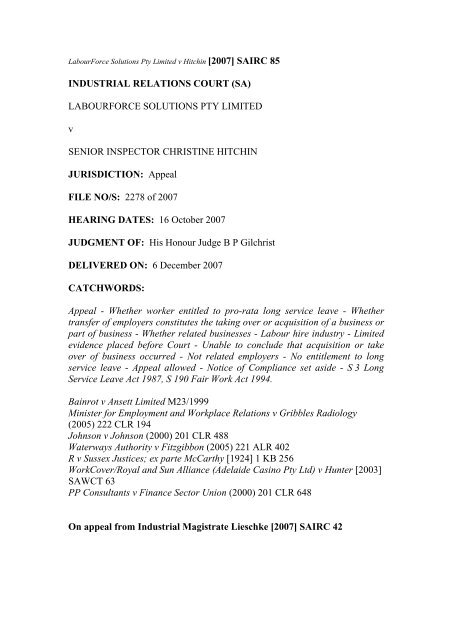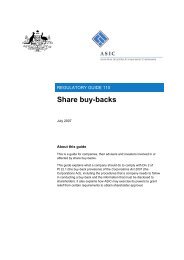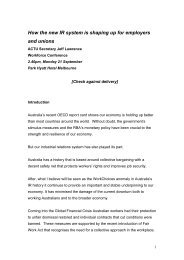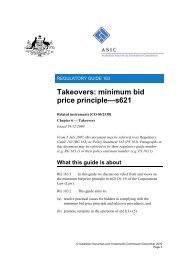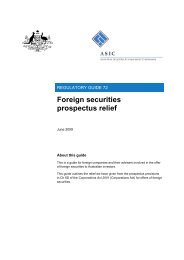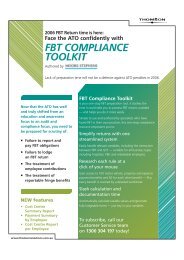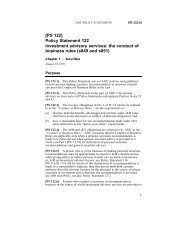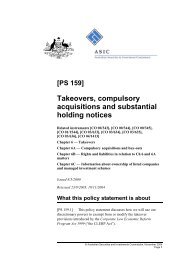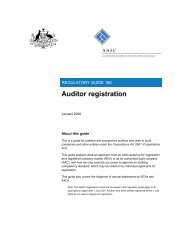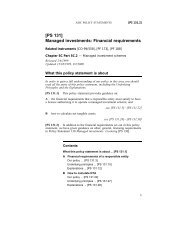LABOURFORCE SOLUTIONS PTY LIMITED v SENIOR INSPECTOR ...
LABOURFORCE SOLUTIONS PTY LIMITED v SENIOR INSPECTOR ...
LABOURFORCE SOLUTIONS PTY LIMITED v SENIOR INSPECTOR ...
You also want an ePaper? Increase the reach of your titles
YUMPU automatically turns print PDFs into web optimized ePapers that Google loves.
LabourForce Solutions Pty Limited v Hitchin [2007] SAIRC 85<br />
INDUSTRIAL RELATIONS COURT (SA)<br />
<strong>LABOURFORCE</strong> <strong>SOLUTIONS</strong> <strong>PTY</strong> <strong>LIMITED</strong><br />
v<br />
<strong>SENIOR</strong> <strong>INSPECTOR</strong> CHRISTINE HITCHIN<br />
JURISDICTION: Appeal<br />
FILE NO/S: 2278 of 2007<br />
HEARING DATES: 16 October 2007<br />
JUDGMENT OF: His Honour Judge B P Gilchrist<br />
DELIVERED ON: 6 December 2007<br />
CATCHWORDS:<br />
Appeal - Whether worker entitled to pro-rata long service leave - Whether<br />
transfer of employers constitutes the taking over or acquisition of a business or<br />
part of business - Whether related businesses - Labour hire industry - Limited<br />
evidence placed before Court - Unable to conclude that acquisition or take<br />
over of business occurred - Not related employers - No entitlement to long<br />
service leave - Appeal allowed - Notice of Compliance set aside - S 3 Long<br />
Service Leave Act 1987, S 190 Fair Work Act 1994.<br />
Bainrot v Ansett Limited M23/1999<br />
Minister for Employment and Workplace Relations v Gribbles Radiology<br />
(2005) 222 CLR 194<br />
Johnson v Johnson (2000) 201 CLR 488<br />
Waterways Authority v Fitzgibbon (2005) 221 ALR 402<br />
R v Sussex Justices; ex parte McCarthy [1924] 1 KB 256<br />
WorkCover/Royal and Sun Alliance (Adelaide Casino Pty Ltd) v Hunter [2003]<br />
SAWCT 63<br />
PP Consultants v Finance Sector Union (2000) 201 CLR 648<br />
On appeal from Industrial Magistrate Lieschke [2007] SAIRC 42
Labourforce Solutions Pty Limited v Hitchin 2 Gilchrist J<br />
[2007] SAIRC 85<br />
REPRESENTATION:<br />
Counsel:<br />
Appellant:<br />
Respondent:<br />
Solicitors:<br />
Appellant:<br />
Respondent:<br />
Mr J Darams<br />
Mr S McDonald<br />
Clayton Utz<br />
Crown Solicitors Office
Labourforce Solutions Pty Limited v Hitchin 3 Gilchrist J<br />
[2007] SAIRC 85<br />
1 This is an appeal that involves the construction of the expression “takes<br />
over or otherwise acquires the business or part of the business of the<br />
other” for the purposes of s 3 of the Long Service Leave Act 1987 and the<br />
application of that expression and the facts of this case.<br />
2 It arises out of an appeal from the decision of a learned Industrial<br />
Magistrate who had, despite his protest, placed before him very limited<br />
evidence.<br />
3 The issue before the learned Industrial Magistrate was whether<br />
Mr George Mettyear was entitled to pro rata long service leave upon the<br />
termination of his employment from the appellant, Labourforce Solutions<br />
Pty Ltd. That in turn depended upon whether Labourforce, which is a<br />
labour hire company, had taken over or acquired part of the business of<br />
another labour hire company, Rexco Pty Ltd, for whom Mr Mettyear had<br />
previously worked.<br />
4 A brief statement of agreed facts that was tendered at trial revealed that<br />
Mr Mettyear commenced employment with Rexco during October 1999<br />
and that on about 22 October Rexco placed him at Iplex Pipelines<br />
Australia Pty Ltd to perform maintenance work as a special class<br />
electrician at its Elizabeth factory. Mr Mettyear worked continuously for<br />
Rexco at the factory until 7 June 2002.<br />
5 On the following working day, 11 June, Mr Mettyear commenced<br />
working for Labourforce. Labourforce effectively replaced Rexco and<br />
Mr Mettyear worked continuously for it at the factory until<br />
8 December 2006.<br />
6 Under the terms of the Long Service Leave Act an employee is entitled to<br />
receive pay in lieu of pro rata long service leave upon termination after a<br />
minimum period of seven years continuous service with the same or<br />
related employers. The expression “related employers” is defined to<br />
include one that “takes over or otherwise acquires the business or part of<br />
the business of the other”.<br />
7 Usually issues relating to long service leave come before the Court<br />
through an action for underpayment of wages. They can, however, come<br />
before the Court by other means. The Long Service Leave Act gives an<br />
inspector appointed under the Fair Work Act the authority to issue a<br />
compliance notice directing an employer to grant long service leave or to<br />
make payment in lieu, if the inspector is satisfied that the employer has<br />
improperly refused to grant the leave or make the payment.<br />
8 The respondent, Inspector Hitchin, is an inspector appointed under the<br />
Fair Work Act. She believed that Mettyear’s transferral of employment<br />
for Rexco to Labourforce satisfied the statutory definition of related
Labourforce Solutions Pty Limited v Hitchin 4 Gilchrist J<br />
[2007] SAIRC 85<br />
employers. She therefore issued a compliance notice directing<br />
Labourforce to pay Mr Mettyear long service leave.<br />
9 Labourforce sought a review of that notice culminating in the hearing<br />
before the learned Industrial Magistrate. He upheld the compliance notice<br />
and that is the decision that is the subject of this appeal.<br />
10 The statement of agreed facts noted that the duties performed by<br />
Mr Mettyear at the factory for Labourforce were the same as those that he<br />
performed there when he worked for Rexco.<br />
11 The learned Industrial Magistrate received a written statement from<br />
Mr Robert Edwards, who at all relevant times was Labourforce’s<br />
Business Development Manager.<br />
12 Mr Edwards said that Labourforce supplied labour to Iplex in various<br />
States and from October 2000 that included South Australia. He said that<br />
by June 2002 Labourforce supplied about ten or twelve employees who<br />
worked at the factory in Iplex’s production and process department and<br />
another three or four employees who worked in Iplex’s warehouse. He<br />
said that at around that time Iplex had its own workforce of about 50<br />
working at the factory and it also engaged the services of five<br />
maintenance workers who were supplied to it by Rexco. One of those was<br />
Mr Mettyear.<br />
13 Mr Edwards said that in May of that year he had a meeting with Iplex’s<br />
General Manager, Mr Russell Wheeler, and was told that Iplex wanted<br />
Labourforce to “do all the maintenance work…”. This was understood to<br />
relate to maintenance work being undertaken at the factory.<br />
14 Mr Edwards indicated that he would need to talk to those engaged by<br />
Rexco and said words to the effect: “If they are happy to switch across<br />
that’s fine. But if they won’t come across we will have to find<br />
replacements”. He said that Mr Wheeler said words to the effect:<br />
“Ian Brooker is in charge of the maintenance guys. I’ll set up a time for<br />
you to speak to him and bring him up to speed about what is going to<br />
happen.”<br />
15 Mr Edwards met with the Rexco employees working at the factory and all<br />
of them, including Mr Mettyear, commenced employment with<br />
Labourforce on 11 June 2002.<br />
16 The learned Industrial Magistrate heard evidence from Mr Mettyear.<br />
17 Mr Mettyear said that the person who was responsible for managing his<br />
employment at the factory was Mr Brooker. He described Mr Brooker as<br />
the maintenance manager and said that was an employee of Iplex.
Labourforce Solutions Pty Limited v Hitchin 5 Gilchrist J<br />
[2007] SAIRC 85<br />
18 He said that when he was working at the factory he did so at a specified<br />
workbench. He said that when he moved from Rexco to Labourforce his<br />
duties were exactly the same and he worked at the same bench.<br />
19 Mr Mettyear was asked some questions about others that worked at the<br />
factory. He confirmed that Iplex employed some of them directly and that<br />
some were supplied by other labour hire companies.<br />
20 He was asked some questions about the maintenance section:-<br />
“Q The other maintenance employees – can you tell me who they<br />
were, at the time when you began?<br />
A<br />
Q<br />
A<br />
Time that I began? Well, there was Gordon Wainman,<br />
Tony Sangregorio. Scott Atkins was a Rexco employee,<br />
Darren Koch, Cliff Walkington – I think his name was…<br />
Obviously while you were there some employees would have<br />
come and gone?<br />
For sure, yes.”<br />
21 He was then asked:-<br />
“Q You said there were other electricians there. Mr Edwards says<br />
in his statement there was probably one other electrician. I’m<br />
not sure at what stage that was. Do you recall whether it was<br />
one or more other electricians?<br />
A<br />
When I first started with Rexco in 99 there was three other<br />
electricians besides myself. Two of those were got rid of<br />
between that period between Rexco and LabourForce. When<br />
LabourForce took over, there was one other electrician. His<br />
name was Scott Atkins.<br />
Okay, and did he do the same work as you?<br />
A<br />
Q<br />
A<br />
Q<br />
He did the same work as me.<br />
Were you interchangeable effectively?<br />
Yes. He now works for Iplex Pipelines….<br />
You said Scott was employee by Iplex. Do you know when<br />
that happened? I’m curious about whether that was after<br />
LabourForce became your employer?<br />
A. I believe it was – no. No, that was when Rexco was his<br />
employer. There was another electrician Craig Garde and he<br />
had only been with Rexco for one week before LabourForce
Labourforce Solutions Pty Limited v Hitchin 6 Gilchrist J<br />
[2007] SAIRC 85<br />
took over. Craig Garde took over Scott Atkins’ position.<br />
Scott went to work for Iplex.”<br />
22 Also placed in evidence before the learned Industrial Magistrate was a<br />
letter that was sent out by Iplex to all of its employees on 8 December<br />
2006. It commenced:-<br />
“Please be advised that effective Saturday 9 December 2006, the<br />
company has decided to outsource all maintenance tasks to a<br />
company called O’Donnell Griffin.”<br />
It ended with the following statement:-<br />
“We will continue to retain our existing full time maintenance and<br />
tool making employees.”<br />
23 It was an agreed fact that there was no commercial relationship between<br />
Labourforce and Rexco.<br />
24 The learned Industrial Magistrate identified the issues for his<br />
determination as being:-<br />
• Whether Labourforce needed to be in some form of<br />
relationship with Rexco that included the transfer of assets.<br />
• Whether a part of Rexco’s business was the supply of all<br />
maintenance workers for Iplex’s Elizabeth factory.<br />
25 On the first issue Labourforce submitted to the learned Industrial<br />
Magistrate that a necessary ingredient of the expression “takes over or<br />
otherwise acquires the business or part of the business of the other” is the<br />
existence of a commercial relationship between the one business and the<br />
other that led to the takeover or acquisition and that as that was lacking<br />
here the claim had to fail.<br />
26 The learned Industrial Magistrate rejected that submission. In doing so he<br />
relied on the decision of Mr Hardy IM in Bainrot v Ansett Limited 1 where<br />
Hardy IM said:-<br />
“It is my view that the Act uses the terms in a broader sense and in<br />
a manner intended to preserve the rights of employees to long<br />
service leave despite changes in ownership of the business in which<br />
they have been to all intents continuously employed. The 1987 Act<br />
does away with the previous of concept of a “transmission”<br />
between employers wherein continuity of service was deemed not<br />
to be broken… I am of the view that the current legislation is<br />
considerably wider than that in that it introduces the concept of<br />
‘related’ employers which is so deemed by virtue of no more than a<br />
1 M23/1999
Labourforce Solutions Pty Limited v Hitchin 7 Gilchrist J<br />
[2007] SAIRC 85<br />
taking over or acquiring of the business and not by virtue of any<br />
agreement or operation of law.”<br />
27 As to the second issue the learned Industrial Magistrate found that:-<br />
“Rexco’s business was to provide labour to different clients. The<br />
provision of all maintenance labour to Iplex was a severable and<br />
distinct part of Rexco’s broader business operations. … It was an<br />
exclusive commercial relationship with one customer. The workers<br />
were to provide a defined maintenance function. The work was<br />
performed at the same place and on a continuous basis. In my view<br />
the exclusive supply of all skilled labour to Iplex for its factory<br />
maintenance needs was a part of Rexco’s business.”<br />
(emphasis mine)<br />
28 Having found that: “Labourforce started to do exactly the same and again<br />
on an exclusive basis” the learned Industrial Magistrate concluded that<br />
this part of Rexco’s business was acquired by Labourforce. He therefore<br />
found that the legislative definition of related employers was satisfied and<br />
for that reason upheld the compliance notice.<br />
29 On appeal Labourforce contended that the learned Industrial Magistrate<br />
erred on both issues.<br />
30 On the commercial element point it maintained its contention that the<br />
relevant statutory provision envisages a commercial relationship between<br />
the two employers. I was taken to a number of cases decided by this Court<br />
concerning the relevant provision in which there was a discussion about<br />
the commercial relationship between the former and later employer. It<br />
was rhetorically asked: If this was an irrelevant inquiry why the<br />
discussion?<br />
31 The fallacy in that argument is that is does not follow as a matter of logic<br />
that because the absence of a commercial relationship is not decisive it is<br />
irrelevant. The fact of a commercial agreement between the former and<br />
later employer might throw light upon whether or not there has been an<br />
acquisition or takeover of part of a business. Hence, even though proof<br />
one-way or the other is not decisive, it may nevertheless be a fruitful<br />
inquiry. The High Court said as much in Minister for Employment and<br />
Workplace Relations v Gribbles Radiology 2 :-<br />
“Where there has been some transaction between them, it will be<br />
possible to see whether the former employer transferred the whole,<br />
or part, of its business to the new employer.”<br />
32 Moreover, I agree with the observations of Hardy IM that the answer lies<br />
in the history of the provision. By amending the Act Parliament revealed<br />
2 (2005) 222 CLR 194 at 212.
Labourforce Solutions Pty Limited v Hitchin 8 Gilchrist J<br />
[2007] SAIRC 85<br />
an intention to widen the circumstances in which earlier service would<br />
qualify for inclusion in the calculation of an entitlement to long service<br />
leave. That being so there is no warrant to read into the expression takes<br />
over or otherwise acquires a commercial element. In note the High Court<br />
arrived at a similar conclusion, albeit in the context of a different Act, in<br />
Gribbles where they said:-<br />
“…there may be no transaction between the two employers but it<br />
may be clear that the new employer is the successor of the business<br />
of the former employer. Thus, the existence of some transaction<br />
between the two employers is not essential in order to show that<br />
one is the successor to the business of the other.” 3<br />
33 In my opinion the learned Industrial Magistrate’s rejection of<br />
Labourforce’s submission on this issue was correct.<br />
34 As to the other issue, underpinning the learned Industrial Magistrate’s<br />
conclusion was his identification of the relevant part of Rexco’s business<br />
as being the labour associated with all of Iplex’s skilled maintenance<br />
workers at the factory.<br />
35 There was evidence pointing towards this conclusion but there was also<br />
evidence pointing the other way.<br />
36 There was evidence from Mr Edwards about Iplex wanting Labourforce<br />
to do all the maintenance work, but Mr Edward’s statement also referred<br />
to Mr Brooker and we know that he was the head of the maintenance team<br />
at the factory and that he worked directly for Iplex. It leaves open the<br />
possibility that when Mr Edwards was speaking of Labourforce doing all<br />
of the maintenance work he meant all of the maintenance work then being<br />
carried out at the factory by Rexco.<br />
37 Mr Mettyear talked of Rexco employing all of the maintenance<br />
employees but what is to be made of his evidence regarding<br />
Mr Scott Atkins? It strongly suggests that Mr Atkins was working for<br />
Iplex by the time Labourforce took over. It leaves open the possibility of<br />
an inference that Mr Atkins was working for Iplex as a maintenance<br />
worker at the factory.<br />
38 Finally, what is to be made of the statement in Iplex’s letter of<br />
8 December 2006 about it retaining its existing full time maintenance<br />
employees? This strongly indicates that it directly employed maintenance<br />
workers at the factory. We do not know when they did so but the<br />
statement is consistent with it employing some maintenance workers there<br />
when Labourforce began employing Mr Mettyear.<br />
3 (2005) 222 CLR 194 at 212.
Labourforce Solutions Pty Limited v Hitchin 9 Gilchrist J<br />
[2007] SAIRC 85<br />
39 Collectively this evidence places real doubt about the extent to which<br />
Iplex supplied some its own staff to perform maintenance work. We know<br />
for certain that when Labourforce began employing Mr Mettyear, Iplex<br />
directly employed one maintenance worker, Mr Brooker. It may have<br />
employed a second, Mr Atkins. It may have employed others.<br />
40 There was no discussion about these matters by the learned Industrial<br />
Magistrate.<br />
41 With respect I have two difficulties about this.<br />
42 The learned Industrial Magistrate may have considered all of the evidence<br />
and reached the conclusion that notwithstanding the evidence suggesting<br />
otherwise, overall the evidence supported the conclusion that it was part<br />
of Rexco’s business to the supply all skilled maintenance workers at the<br />
factory. In that event, with respect, I think his reasons were inadequate.<br />
43 The adequacy of reasons has to be looked at through the eyes of the<br />
hypothetical reasonable bystander that is spoken of in cases such as<br />
Johnson v Johnson 4 . The bystander’s views about the adequacy of reasons<br />
reflects the parties’ and the public’s need for justice to be “manifestly and<br />
undoubtedly be seen to be done”. 5 Absent a discussion of this evidence<br />
the hypothetical reasonable bystander would, in my view, conclude that<br />
this has not occurred.<br />
44 The learned Industrial Magistrate’s failure to discuss this evidence may<br />
reflect his failure to consider it. In that event he denied himself of the<br />
possibility of finding that Rexco supplied some, but not all of the<br />
maintenance workers at the factory. That finding could have led to a<br />
conclusion that in employing these maintenance workers Labourforce did<br />
not take over or acquire part of Rexco’s business.<br />
45 On either count there has been a miscarriage of justice that requires<br />
intervention. The issue that then arises is what should that intervention<br />
comprise of.<br />
46 The Fair Work Act 1994 governs the appeal before me. The powers of the<br />
Court sitting on appeal are sufficiently wide to make it clear that the<br />
hearing before me is a rehearing and, subject to the constraints that can<br />
arise if issues of credit are involved, I am obliged to attempt to reach my<br />
own conclusion on the facts and the law. I should only remit the matter<br />
for a re-trial if I am satisfied that I cannot do justice between the parties<br />
by basing my decision on the written material alone.<br />
4 (2000) 201 CLR 488 at 508 – 9.<br />
5 R v Sussex Justices; ex parte McCarthy [1924] 1 KB 256 at 259; WorkCover/Royal and Sun Alliance<br />
(Adelaide Casino Pty Ltd) v Hunter [2003] SAWCT 63 at para 66.
Labourforce Solutions Pty Limited v Hitchin 10 Gilchrist J<br />
[2007] SAIRC 85<br />
47 Like the learned Industrial Magistrate I am concerned by paucity of<br />
evidence. In light of that I have given anxious consideration as to whether<br />
the better course is to remit the matter for a re-trial in the hope that this<br />
might yield a sounder evidentiary basis upon which to decide this case. I<br />
have nevertheless resolved that I should not take that course. To borrow<br />
the words of Kirby and Heydon JJ “…the first trial was not a rehearsal,<br />
warm up or dummy run. It must have been conducted against the<br />
possibility of all available factual findings being made [or the lack of<br />
them]” 6 . (new words added mine)<br />
48 Moreover, the parties could have but did not seek to adduce further<br />
evidence before me. 7<br />
49 That being so and given that there are no issues of credit that depend upon<br />
an evaluation of evidence that could be influenced by observing oral<br />
testimony being given, the proper course is for me to decide the case<br />
myself.<br />
50 Having re-evaluated the evidence I find that Rexco was at all relevant<br />
times a labour hire company. I find that as at June 2002 it was supplying<br />
five tradespersons to Iplex and that these tradespersons undertook<br />
maintenance work at the factory and worked under the supervision of a<br />
supervisor who worked for Iplex. In June 2002 these tradespersons began<br />
working for Labourforce doing the same work at the same location as<br />
they were when they worked for Rexco. At least one of these<br />
tradespersons, Mr Mettyear, had been doing the same work at Iplex since<br />
October 1999. Mr Mettyear worked continuously at Iplex until December<br />
2006. I do not know what became of the other four tradespersons.<br />
51 The evidence does not permit me to make any other findings about<br />
Rexco. I do not know, for example, whether these five tradespersons were<br />
the only tradespersons that Rexco employed in South Australia or<br />
anywhere else as at June 2002.<br />
52 Prior to June 2002 Labourforce was also supplying labour to Iplex at the<br />
factory and elsewhere. None of those working at the factory were<br />
undertaking maintenance work. The evidence does not permit me to make<br />
any other findings about Labourforce. I do not know, for example,<br />
whether the five tradespersons who commenced working for it in June<br />
2002 where the only tradespersons working for it at the factory, or in<br />
South Australia, or anywhere else.<br />
53 As at June 2002 Iplex directly employed at least one person, the<br />
supervisor, in connection with the maintenance work at the factory. It<br />
6 Waterways Authority v Fitzgibbon (2005) 221 ALR 402 at 426.<br />
7 See: s 190(2) Fair Work Act 1994.
Labourforce Solutions Pty Limited v Hitchin 11 Gilchrist J<br />
[2007] SAIRC 85<br />
may have directly employed another, Mr Atkins to work there. It is<br />
conceivable that it may have employed others.<br />
54 In light of these findings I now turn to consider whether Labourforce took<br />
over or acquired part of Rexco’s business.<br />
55 In a sense, everyone who is employed by a commercial entity is a part of<br />
the business of that entity. In that sense, whenever an employee leaves the<br />
employ of one employer and goes to another the later employer takes over<br />
or acquires a part of the business of the former employer. It cannot,<br />
however, have been Parliament’s intention that the word “business”<br />
would have such a wide meaning. Otherwise it would have simply<br />
provided that whenever an employee leaves the employment of one<br />
employer and moves to another the earlier service carries over for the<br />
purposes of the Long Service Leave Act. Something more is required.<br />
56 In resolving this issue I think that the approach suggested by Gleeson CJ,<br />
Gaudron, McHugh and Gummow JJ in PP Consultants v Finance Sector<br />
Union should be adopted. There they said:-<br />
“The question whether one person has taken over or succeeded to<br />
the business or part of the business of another is a mixed question<br />
of fact and law. For this reason and, also, because "business" is a<br />
chameleon-like word, it is not possible to formulate any general<br />
test to ascertain whether, for the purposes of s 149(1)(d) of the Act,<br />
one employer has succeeded to the business or part of the business<br />
of another. Even so it is possible to indicate the manner in which<br />
that question should generally be approached, at least when a nongovernment<br />
employer succeeds to the commercial activities of<br />
another non-government employer …<br />
As a general rule, the question whether a non-government<br />
employer who has taken over the commercial activities of another<br />
non-government employer has succeeded to the business or part of<br />
the business of that other employer will require the identification or<br />
characterisation of the business or the relevant part of the business<br />
of the first employer, as a first step. The second step is the<br />
identification of the character of the transferred business activities<br />
in the hands of the new employer. The final step is to compare the<br />
two. If, in substance, they bear the same character, then it will<br />
usually be the case that the new employer has succeeded to the<br />
business or part of the business of the previous employer.” 8<br />
57 Since I do not know how many people Rexco employed or what range of<br />
skills and experience it employees possessed as at June 2002 and I know<br />
that Iplex employed at least one person and perhaps more as part of the<br />
8 (2000) 201 CLR 648 at 655.
Labourforce Solutions Pty Limited v Hitchin 12 Gilchrist J<br />
[2007] SAIRC 85<br />
maintenance team at the factory I find it difficult to identify or<br />
characterise the labour that Rexco was supplying to Iplex at that time.<br />
58 For the reasons set out above the evidence does not substantiate a finding<br />
that Rexco was supplying Iplex with all of the factory’s maintenance<br />
needs as at June 2002. Indeed the evidence is such that I am not prepared<br />
to find that Rexco was supplying Iplex with all of the factory’s<br />
maintenance needs as at June 2002, other than the supervisor. It might<br />
have, but such is my uncertainty about Mr Atkins I am not satisfied to the<br />
requisite degree that it did.<br />
59 If the only tradespersons that Rexco employed at all or perhaps even in<br />
South Australia as at June 2002, were the five tradespersons that it was<br />
then supplying to Iplex at the factory, I might have been able to identify<br />
them as such and characterise them as an identifiable part of Rexco’s<br />
business capable of being taken over or acquired. I do not, however, have<br />
to resolve this issue because the evidence does not enable me to make<br />
such a finding.<br />
60 The state of the evidence is such that the only identification or<br />
characterisation that I can make of the five tradespersons that Rexco was<br />
supplying to Iplex in June 2002 for work at the factory is that they<br />
comprised of an unknown proportion of the tradespersons engaged by<br />
Rexco in South Australia who worked at a particular site supplementing<br />
an indeterminate proportion of the maintenance needs of their host<br />
employer. I would not identify or characterise this as part of Rexco’s<br />
business capable of being taken over or acquired.<br />
61 In other words, the lack of evidence is such that the resolution of the<br />
second step that was spoken of in PP Consultants, being the identification<br />
of the character of the transferred business activities in the hands of the<br />
new employer, does not arise. Nor, obviously, does the final step of<br />
comparing the two.<br />
62 In my opinion, the limited evidence placed before the Court did not<br />
enable findings to support a conclusion that in employing these<br />
tradespersons Labourforce took over or acquired part of Rexco’s business.<br />
Labourforce and Rexco were therefore not related employers. As this was<br />
the only basis upon which it was contended that Mr Mettyear was entitled<br />
to pro-rata long service leave the notice cannot stand.<br />
63 The appeal is allowed and the notice of compliance is set aside.


